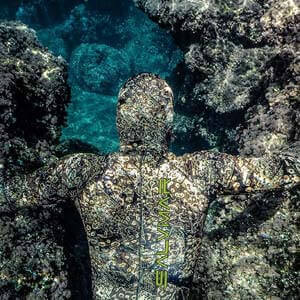For UK diving you will need a 5mm wetsuit to dive through most of the year. It’s common practice for more hardcore divers to use a 2mm vest or 7mm wetsuit jacket in the winter to make the most of the fishing all year round. Camouflage is a matter of preference, and it is arguable if it makes any difference at all.
Make sure you put hot water mixed with a powder wetsuit lubricant such as Octacle or Slippy in the suit before putting it on. Shampoo or conditioner will work but it’s messy and gets in your eyes; it’s also not healthy for the marine environment. The lubes are completely natural and stick in the neoprene rather than flushing straight out, making the suit much easier to get on and off. Spearfishing suits need to be wet to put on, but they are more comfortable and warmer because of the sticky open cell construction. The lined open cell is the common format for these suits, meaning the raw sticky neoprene is on the inside and the nylon lining like your surf or scuba suit is on the outside – making these suits very durable but also very soft and stretchy. This may sound odd at first, but once you’re used to the technique, it’s super easy to slide in to one of these suits and they will enhance your spearfishing experience massively.
You do also find full Smoothskin neoprenes which have zero nylon lining: these suits dry very quickly and are best for boat diving where wind chill is an issue. As there is no nylon to hold water, you don’t feel the cold from the wind and stay much warmer. However, as they are only glued together, they are easy to damage and rip apart. The solution to this is the sandwich-type suit such as the Polosub Forza Tre, Cressi Ricciola or Epsealon Fusion Skin. These suits are lined open cell suits with a layer of smoothskin on the outside, meaning they are super durable and also just as warm as a smoothskin with no downside aside from the price. These two types of suits range from £350 upwards with most around £350-£600.
What is a spearfishing wetsuit?
A typical spearfishing suit will consist of two parts, the high waist trousers and the hooded jacket (Salvimar Krypsis 101 Full Two Piece Wetsuit – Spearfishing UK). These also come in various configurations, such as with trousers that finish at the waist or shoulder straps with the main torso also being covered (called “Long Johns”) Picasso Camo Ghost Wetsuit Farmer John Trousers – Spearfishing UK. You can also get one-piece versions, but these are not so popular hence our limited stock of this style.
The trousers and jacket combo makes these suits easier to get on, and also doubles the amount of neoprene over your core: this makes them much warmer than other suits of the same thickness such as a surf suit. 5mm is the preferred/go-to thickness for the UK spearo and will generally be warm enough for the entire year. However, for the winter months or spearfishing further north, a 7mm full suit or top should be considered. Another cheap option for keeping warm in the winter months is using a neoprene vest under the top (Epsealon Black Under Vest 2.5mm – Spearfishing UK).
In slightly warmer climates where they can get away with it, Spearos will often tend to use thinner (3mm) two-piece suits (most brands/models of suit will have 3mm wetsuit options even if they are not explicitly listed on the site). In warmer water still – during the summer months in the Caribbean for example – you’ll often see spearfishermen in rash-vests and shorts…
Unlike your surf or scuba suit, open cell suits are designed to be able to deal with rapid compression during freediving. Your scuba suits will fair okay but tend to be stiff and compress quicker over time. Surf suits will also compress very quickly, so it’s best to only use them for surface stalking: leave your posh O’Neil surf suit at home and invest in a good spearo suit. Suits are getting cheaper and cheaper these days and you can pick up an excellent suit made with green Jako or Yamamoto neoprene for £200-£250, such as the Jak Boeno Quartz or Thermoskin. Most suits are £200-£330 for a full 5mm and should easily last 3-5 years with very little compression unless you’re a deeper diver and like to hunt 15-25m on a regular basis.
Finding the best fit
Much like with masks, the best wetsuit is always the one that fits. This must be the first consideration before anything else, as an ill-fitting wetsuit won’t function as it should! Forget the camo or brand loyalty – if it doesn’t fit then it’s a waste of money. Any bagginess in the suit, behind the neck or under your arms for example, will cause water to pool, making you cold; however, you should get a small gap under the armpits to allow you to stretch your arms.
All off-the-shelf branded suits are pre-made to accommodate a certain body type/shape. This varies between the brands – for example, Salvimar will fit a slimmer taller build, whereas Moray will fit a larger, broader build – it’s not standardised like in surfing. Sadly, this can restrict a lot of people to certain brands.
To find the best suit for you, first you must take measurements for height, weight, chest and waist. Compare these to the size guides included in the product images on the website. If you’re within the margins, you’re looking at a good fit.
- If you’re tall and slim, look at Salvimar, Pathos and Epsealon.
- For an average build look at Jak Boeno and Cressi
- If you have broader shoulders or are more of a muscular or stockier build, look at Moray, and Picasso. All our suits can be found here: Wetsuits – Spearfishing UK
Wetsuit Fit/Body Type
- Salvimar & Pathos = Slim & Tall
- Abysstar = Slim
- Epsealon = Slim/Athletic
- Jak Boeno = Athletic/Average
- Labrax = Athletic/Average
- Riffe = Athletic/Average
- Cressi = Average
- Picasso = Stocky
- Moray = Broader Shoulders/Muscly/Stocky
We tend to find the Salvimar, Epsealon, Jak Boeno and Moray to be the most popular suits, with Pathos and Cressi following close behind.
Green Neoprenes
What is Green Neoprene? These are neoprenes made from limestone rather than petroleum, meaning they have a much smaller carbon footprint and are far more sustainable to manufacture.
Yamamoto are the industry leader in the eco-neoprene sector and have been operating since 1961, their products in particular are made from extremely pure limestone containing 99.7% calcium carbonate from Mt. Kurohime in Japan. They also use hydro and renewable energy power sources to manufacture the neoprene as it is a very energy heavy process.
There is a wide range of neoprenes on the market and most manufacturers are going down the route of offering these types of suits. Generally speaking, the green neoprenes are softer due to larger air bubbles which allows the suit to stretch more without losing its shape. The larger air bubbles also makes the suit warmer. The construction of these neoprenes means they are more durable and will last longer.
However, depending on the type, most greener neoprenes will suffer greater compression at depths past 15/20m than denser neoprenes.
Yamamoto neoprene comes in a few different models, 39 and 45 being the most popular but usually the most expensive when it comes to spearfishing and freediving, due to their excellent stretch.

#38 – Standard – Frequently used as wetsuit material for wild marine sports such as scuba diving, kayaking and sailing, as well as spear fishing.
#39 – Superlight – Used in surfing, triathlons, swimming and spear fishing.
#40 – Super Stretch – This material was developed by improving the flexibility of #39. Surfing and triathlons, which require the wearers to have a flexible range of motion.
#45 – PRO – This material is the most flexible type, and wetsuits made from this material are mainly worn by free divers & spearos
#50 – PRO-X – This type is used by deeper divers who need the most resistance to compression, often found in more commercial usage and professional divers
#88 – Compressed – Mainly used for dry suit construction to offer maximum durability
Chloroprene Rubber vs Natural Rubber.

Image source: https://yamamoto-bio.com/material-e/sus2.html
Jako is another popular green neoprene brand based in Korea founded in 1986, utilising 99% calcium carbonate limestone in their production.
The more durable neoprenes that you commonly find are as follows – Ecoline/Sheico, Nam-Liong, Heiwa, NJN. These will be more resistant to depth and compression and although not as comfortable as Yam or Jako, they will last longer for deeper diving. Most competition divers, however, prefer the advantage of a softer comfier suit, despite its shorter life span.
Ecoline/Sheico and Nam-Liong are the denser and more durable neoprenes and Heiwa and NJN tend to sit in the middle, with Jako and Yamamoto being the most comfortable and softer types.
Custom vs Off-the-Shelf
Most off-the-shelf suits these days cover a wide variety of shapes and sizes, hence the massive range we stock.
Most people can find a suit that fits them well, but there’s often a compromise somewhere – whether that’s the fit, material or aesthetically.
Custom removes any chance of compromise: and brands such as Polosub and XT Diving make excellent custom suits that are fitted exactly to the 20+ measurements required for their suits. With a wide choice of types and camos, you can customise all the options and it will fit right out of the box and last twice as long as an off-the-peg suit.
Our top recommendations:
Green Neoprenes
- Jak Boeno, Thermoskin & Quartz
- Epsealon Shadow & Tactical Stealth
- Salvimar N.A.T & Krypsis 101
- Moray Pelagic & Weedline
Denser Neoprenes
- Pathos – Onyx, Coral & Medi
Smoothskin
- Polosub Custom Smoothskin
- Pathos Team & Ultra
Sandwich
- Epsealon Fusion Skin
- Polosub Custom Forza Tre


